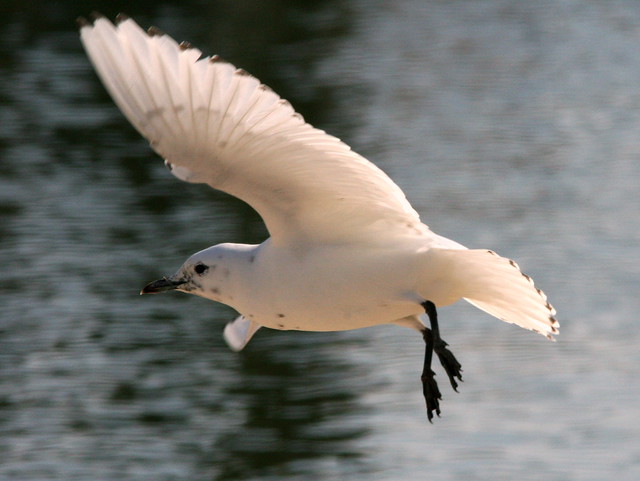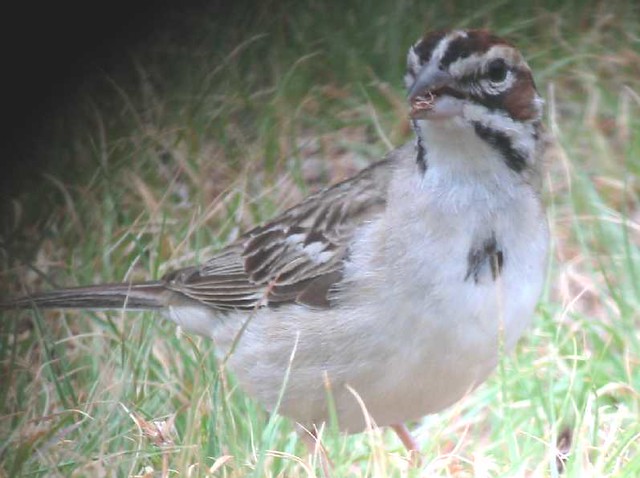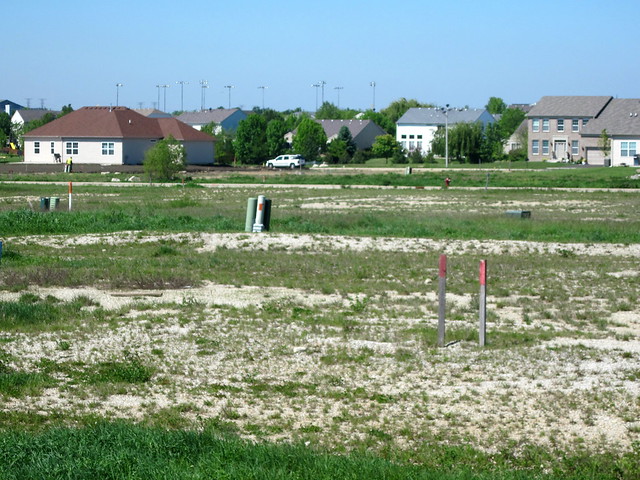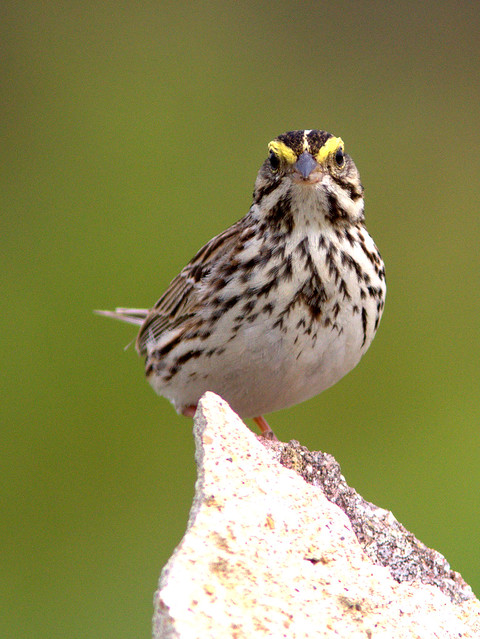Posted by: Ken @ 9:23 am
Most of my posts attest to the fact that I do not range far and wide in search of rare or uncommon birds. It’s not that I lack interest in putting a few new notches in my birding belt. If an unusual bird is reported and it is reasonably nearby, I will make an effort to see it, but I’ve never been one to jump on a plane or drive overnight to join the “twitchers” who congregate in hopes of adding a new species to their life/year/locality lists.
Some of our “rare” bird sightings were incidental to trips we had taken for non-birding reasons. I think of the Piratic Flycatcher that showed up in Fort Sumner, New Mexico just as I was setting out to drive from Albuquerque to Amarillo to visit our son and his family. We diverted from I-40 and lost about an hour of travel time to see it. My digiscoped image of this vagrant from Mexico was taken with a little 2.4 megapixel point-and-shoot camera back in 2003, long before I acquired my first DSLR.
Then, in 2009 there was an Ivory Gull that appeared in Cape May, New Jersey, and was only seen during the week that we flew there for the funeral of my uncle.
In the spring of 2010 we picked up another life bird when local birders found a Ruff that showed up at Nelson Lake Marsh/Dick Young Forest Preserve near our Illinois condo. My photos of the sandpiper, seen here in the foreground, foraging with several Lesser Yellowlegs, were only good enough to document the larger Ruff’s “pot belly,” more upright posture, and drooping bill that set it apart. I must admit that we likely would not have located the bird, much less identified it, without the help of a couple of experts who happened to be there when we followed up on the report. It was my ABA Area Life Bird #572, and Mary Lou’s #505. As evidence of our slow progress to the coveted 600 mark, we now have only advanced to 581 and 509 species respectively.

This past May 15, while Mary Lou and I were birding Lippold Park in neighboring Batavia we saw three or four sparrows and two robins foraging on the trail some distance ahead. All but one of the sparrows were Song Sparrows, but one seemed longer and slimmer and walked instead of hopping. About all we could make out with the binoculars was a strong line over its eye that suggested it was a Lark Sparrow. I took several photos that confirmed its identity. According to eBird, this was the first of this species ever reported from Batavia or any of the neighboring Illinois communities in 10 or more years. Because of the distance, the quality of the photo is poor.
Lark Sparrows are more common in the Western states. Here is another bad shot of one on our lawn in New Mexico, digiscoped through the living room window about 10 years ago.
We watch the local sightings reports, and during the past two weeks we followed up, rather tardily, on a couple of interesting, if not rare, birds.
A Great Horned Owl with two youngsters had been seen roosting the the large oaks in nearby Fabyan Forest Preserve. They were still there despite our delay in searching for them, and they provided a nice photo opportunity.
The owlets were mostly obscured high in the foliage, but they did crane their necks to get a better look at us.
In the case of another recent report of a species that I had not yet photographed, it seems we waited too long after the first sighting. A pair of Red-headed Woodpeckers had been seen courting in an old tree only 3-4 miles from our home. For the past two mornings we spent over an hour observing the nest that the birds had excavated, but there was no sign of them. Perhaps the female was now incubating out of sight, or worse, they had been evicted by some of the European Starlings that were present in large flocks.
All I have to show for our efforts is a photo of their hole with a starling on a nearby branch. Of course we will be back and maybe can report better news about the couple. While a few starlings did roost on the tree, none entered the nest hole, so this may be a sign that the female woodpecker is sitting on eggs.
Our unsuccessful quest tor the Red-headed Woodpecker wasn’t just a “dry hole,” as there were other interesting wild creatures in the vicinity. This Barn Swallow struck a nice pose.
A noisy Eastern Towhee briefly emerged from a secluded perch.
This Red-winged Blackbird added color to the scene as, in song, it displayed its expanded epaulets.
Eastern Kingbirds were gathered in a nearby tree. This one was picking through the grass, probably looking for nest material.
A Killdeer eyed us suspiciously from the shore of the river.
This Chipmunk looks as if it could not stuff one more seed into its cheek pouches.
Eastern Cottontail Rabbits in Illinois appear long-legged and muscular in comparison to…
…the aquatic coastal Florida subspecies of cottontails, little short-eared and dark-furred bunnies known as Marsh Rabbits.
Posted by: Ken @ 9:57 pm
After a lackluster early spring migration season in south Florida, I looked forward to catching up with the northbound warblers in northeastern Illinois. With each passing year I feel added urgency to make the most of every spring and fall. Now it seems that most of the warblers have also bypassed my summer home. In past years, fair numbers of warblers have shown up in local parks and forest preserves.
The warblers have left me high and dry, so instead of a taxonomic species list, I am compiling a color palette. What is prettier than a rainbow? Meet my friend ROY G BIV.
RED
Northern Cardinal, of course!
Thankfully, there have been many Scarlet Tanagers here in Illinois this spring. 
Both the red and the black of the Scarlet Tanager can be challenging for photographers, myself included, as the feather details tend to wash out. 
This first year male Summer Tanager was a surprise visitor to the local Norris Woods Nature Preserve. They usually don’t venture this far north. He sang like a seasoned veteran, making him easy to find in the treetops. Getting a shot of his entire body among the leaves was another matter.
The Rose-breasted Grosbeak qualifies in the “Red” category…
…as does this Red-bellied Woodpecker, whose head attracts much more attention than his undersides.
ORANGE
Of course, the Baltimore Oriole belongs in this category,…
…as does the Monarch Butterfly.
More subdued, the Eastern Question Mark gets its name from a very inconspicuous identification mark. 
The undersides of the Question Mark make it invisible among dry leaves and tree bark, but this view shows the signature punctuation mark on its right wing (partially obscured by the flower on the left). Use your imagination.
YELLOW
This one is easy! An American Goldfinch

Yellow Warblers are nesting and singing in the shrubby fields at Aurora West Forest Preserve.

Common Yellowthroats are reclusive, tantalizing us with loud songs from nearby thickets, but rarely coming out into the open.
This morning I photographed three Eastern Meadowlarks in full song. Here’s one.
Although it is just a spot of color, it is enough to earn the Yellow-crowned Night-Heron its name.
A Tiger Swallowtail certainly belongs here too.
GREEN
I haven’t seen a green bird in Illinois this year, but shot this Female Painted Bunting back in Florida.
In fairness to the female, I will place this male Painted Bunting in this category, though he could fit in at least three.
I captured this free-falling Orange-crowned Warbler here in Illinois in the autumn of 2011
I’m pretty sure this is a Clouded Sulphur, though I left my butterfly field guides back in Florida.
Unless you look closely, this bird appears to be a GINO (green in name only), a Black-throated Green Warbler.
BLUE
Though I’ve seen plenty of these guys here, none posed as nicely as this one that I shot in Florida before departing for Illinois.
INDIGO
Indigo Bunting
Eastern Tailed-Blue Butterfly, a tiny sprite but very colorful when it shows the top of its wings.
VIOLET
I had to reach into the archives again, for this pair of male Boat-tailed Grackles in our Florida back yard
Common Grackles are, well, common in Illinois.
The State Flower of Illinois is the Blue Violet, so this is actually a VINO.
The car can serve as a very effective blind (or hide). One morning earlier this week, with thunder in the background, I drove around the vacant block in front of our northeastern Illinois condo. We are partially surrounded by three city block-sized parcels of land that, within the next week or so, will start to be built up into townhouses. In what was formerly a cornfield, roads and utilities had been installed and 44 of the planned 144 units were finished before the housing slump halted development in 2006.
This is the view from our front door, looking west. Not very pleasing to most folks, but I enjoy all the birds that visit and nest there. After the snow melts and the spring rains come, several large puddles (”fluddles”) attract ducks, geese, cranes and wading birds. The utility markers serve as perches for a variety of prairie birds.
Earlier that morning, I had heard both a Spotted Sandpiper and a Vesper Sparrow singing. Both have nested here in the past, but within a few days, ground will be broken for the remaining 100 new townhouses on this site. Almost immediately I found the sandpiper atop a favorite rock pile, but it flew away as I readied my camera, only to be replaced by a Savannah Sparrow.
The amount of yellow in their eyebrows differs in the several subspecies that breed across the US. The local birds have very prominent yellow brows.
I found the sandpiper again further away in a fluddle across the street.
The sandpipers have nested in the vacant lots every spring since we moved here in 2007. Last year, this one posed on a rock pile.
I had given up the search for the Vesper Sparrow, but stopped in front of our condo to get the mail that I forgot to pick up the day before. I heard it singing on another rock pile and drove back. It posed briefly before disappearing, just as rain started falling.
This streaked Vesper Sparrow shows its characteristic white outer tail feathers and a reddish shoulder patch.
Other species that have nested in this field in past years include Killdeer, Red-winged Blackbird, Eastern Meadowlark, Dicksissel, Song Sparrow and Horned Lark. I had not seen the latter species until a couple of days ago. It’s sad to think that their homes will probably be gone before the end of breeding season.
I photographed an American Kestrel from our front door as it hunted for grasshoppers.
This Eastern Meadowlark appeared to have a swollen ‘ankle.”
A pair of Red-tailed Hawks shared a street light pole.
Late that afternoon, we were leaving our condo to join our daughter and family for dinner. Mary Lou suggested I put the camera in the car instead of storing it in the trunk, as almost every time we pass the vacant lot in front of our building we see interesting birds perched on the posts and rock piles along the road. Sure enough, this Horned Lark posed for several minutes in perfect light.
These are the first photos I have processed on my new wide-screen LCD monitor, a gift from our son-in-law. It is attached to the clunky laptop, and in reviewing my recent shots on FLICKR I can see how poorly I have been able to gauge their quality on the laptop’s murky screen. I also have switched from shooting in RAW, as the laptop’s memory can barely handle the large file size.
In our daughter’s back yard, as I was BBQ’ing fajitas, I heard a Savannah Sparrow singing. I ran for my camera and caught the Savannah Sparrow perching on the fence rail. As I was taking this shot, it stopped moving and cast an anxious glance skyward.
I also looked up to find a Red-tailed hawk soaring overhead, hardly a threat to so small a bird, but enough to trigger its instinct to freeze in place to avoid detection.
A Chipping Sparrow displaced the Savannah Sparrow on the fence and then perched on the tip of a small Blue Spruce tree in their next door neighbor’s yard.
Posted by: Ken @ 6:15 am
We often joke that Florida has two seasons, hot and hotter. We also generally have a dry fall and winter season that gives way to a wet and humid summer. Although our mangoes and avocados put out inconspicuous blossoms, south Florida experiences no explosion of color to mark the onset of the vernal equinox. The mockingbirds sing all year around, though their tempo and volume picks up just as the Palm Warblers depart to breed in far northwestern Canada.
Up north, robins herald the arrival of spring, but we rarely see a robin at any time of the year. For birders looking for warblers, spring migration can be a non-event. If the usual east-west wind pattern persists, it drives northbound birds to the west coast of the Florida peninsula, or they may fly directly from Cuba across the Gulf of Mexico to make landfall.
One bird that can be counted on to arrive at our back yard lake in the middle of April is the Least Tern (Sternula antillarum). While it is the smallest of the tern family at about 9 inches long with a wingspan of 20 inches, it makes up for its small size with graceful energetic flight, strident calls and interesting behaviors. 
There are three distinct populations (subspecies) of Least Terns in the US. One group nests in limited areas on the beaches of western Mexico and California. A second finds sandy places to nest along rivers and streams in the mid-west. Both of these populations are of particular conservation concern. With protection of its nesting areas, the endangered California population has increased from less than 600 pairs in 1974 to over 4500 pairs, while the interior subspecies have increased to 7,000 pairs from a low of 1,000 pairs in 1985 .
Our Florida birds belong to the third subspecies, which breeds up and down the entire US Atlantic coast, wintering in the Caribbean and along the east coast of Central and northern South America. All three populations face threats from human activities, notably destruction of beaches and loss of beach and stream-side habitat. Plume hunters took a huge toll in the late 1800s– I have seen photos of ladies’ dainty hats adorned with the whole bodies of one or more Least Terns. Though not on the Endangered Species list, the U.S. Fish & Wildlife Service lists the east coast Least Terns as a Species of Management Concern.
I bought my Canon 60D camera just a year ago, and my very first practice flight shots were of Least Terns flying past our back patio. This was my first “keeper.”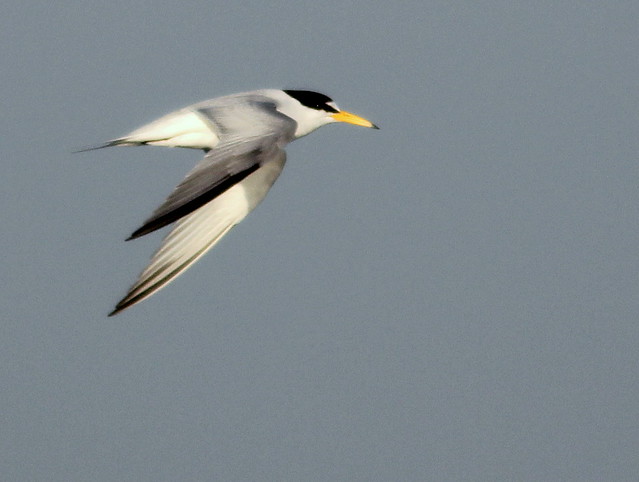
This spring the terns began competing for mates as soon as they arrived. Once bonded, the pair stays loyal to each other for the entire breeding season. The male must prove his prowess as a provider by catching fish and offering it to his intended mate. The male and female plumage is very similar. During breeding season, the males are said to have brighter orange-yellow bills, legs and feet, though this is not very noticeable.
Following the age-old Least Tern courtship ritual, the female waits patiently while her suitor hunts for a small fish. When he catches one, he calls excitedly and flies toward the female’s position, sometimes adding a dramatic flourish by swooping past her. The female eagerly awaits his arrival, calling back and begging.
He then offers her the fish…
…which she gratefully accepts.
As she eats the fish, the male assumes various postures, usually freezing in place for a few seconds.
Here, after she has swallowed it, he continues to point his bill skyward for a moment.
The pair bond is strengthened, and he will repeat the procedure many times. After two or three weeks, if he is accepted, they will mate as he offers a fish. Courtship usually occurs in the foraging area rather than on the nesting grounds.
I am quite sure that Least Terns have nested on the gravel roofs of an elementary school and a strip mall in our neighborhood. Young terns are precocious and are able to walk about soon after hatching, but they remain dependent upon their parents until they move south in late summer.
Last summer these two immature terns were being trained to fish by their parents. The adults would catch a fish and make their youngsters chase after them. The adults would then drop the fish in the water and fly down as if to get to it before the “trainees.” If not retrieved, the parents would pick up the fish and try all over again.
Note that the white area on the forehead of the adult, to the left in this photo, is enlarging. After breeding the adults’ bills and feet also become darker. 
Least Tern immature in flight, July 27, 2011.
First-year birds may remain on their wintering grounds through the next breeding season.
Shared on BIRDING IS FUN, May 3, 2012














